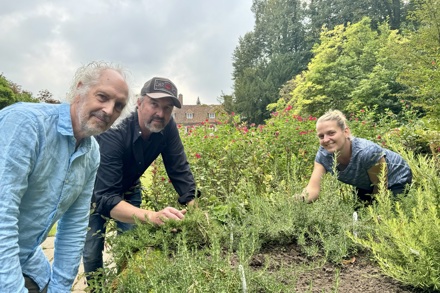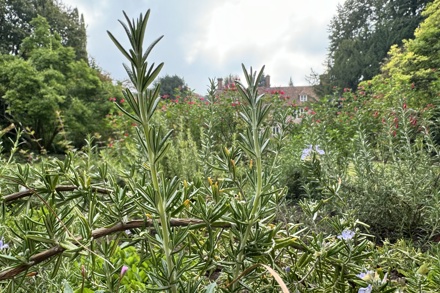When Simon Charlesworth of Downderry Nursery approached retirement, he was looking for a new home for his precious National Plant Collection of Salvia rosmarinus. Thankfully, this magnificent collection of rosemary plants found its way to Great Comp Garden, where it’s now in safe hands with the Garden’s Curator, William Dyson.
William is a world expert on salvia with many years of passion for, and experience of, the genus. He has cultivated over 200 hybrids and species in the nursery at Great Comp Gardens, and has assisted with salvia trials at RHS Wisley. He intends for the collection to be used to educate visitors about rosemary and for them to leave with a greater appreciation for the plants, which are a valuable addition to the garden.
Once established, rosemary is drought-tolerant so an ideal choice for gardens in particularly dry areas and in our increasingly hot and dry summers. Whilst the leaves on all rosemary plants are edible, some varieties may be tastier than others. It is also possible to make a tea with fresh or dried leaves, which is said to help with digestion, memory and concentration. Rosemary plants are a host for the Xylella fastidiosa bacteria, which means they are banned from import unless under a strict licence. The RHS only allows UK grown rosemary at its shows, so collections such as the one at Great Comp provide a crucial, stable source of bacteria free plant material.

Dr Simon Charlesworth William Dyson and Kristyna Kay-Clough with the National Collection of Rosemary at Great Comp Garden.
Vikki Rimmer

Rosemary at Great Comp Garden
Vikki Rimmer
William Dyson, Curator at Great Comp Garden said: We’re really delighted that Simon has entrusted his National Collection to us, which will be an educational resource in the garden. We'd like to foster a deeper appreciation for rosemary with our visitors. It’s a drought tolerant plant so with our changing climate and warmer, drier summers becoming more common, it’s a must have for the gardens of the future. Pale blue, white or pink flowers in mid spring to summer make for an attractive sight in the border, plus they’re also popular with pollinators. The collection is a wonderful addition to our existing salvias, and it has settled in well this summer with all plants putting on a decent amount of growth. We have irrigated on an ‘as and when necessary’ basis because most of the plants are situated in very dry soil, in full sun. My favourites among the new collection are:
- ‘Majorca Pink’ this is an exceptionally floriferous form which seems much hardier than we
were expecting. When in flower, it is the variety that receives most attention from our
visitors - ‘Capercaillie’ is not the hardiest and suffered badly last winter. It has interesting fresh-green
foliage and abundant flowering. It’s probably the most floriferous in the collection but best
grown in a pot and given shelter over winter - ‘Green Ginger’, I love its wonderful ginger-like aroma and very neat habit
- ‘Margaret Sarah’ has pure white flowers and a neat, upright habit
- I also love ‘Sorcerer’s Apprentice’ – this diminutive form seems to have the darkest flowers in
the collection and is very striking.
Gwen Hines, CEO of Plant Heritage, added: It’s fantastic to have people who care about plant conservation coming forwards to start new National Plant Collections. Over four decades, we have demonstrated that this flagship conservation scheme is an effective way to protect special plants. It’s especially encouraging to have a longstanding collection like this successfully transitioned to a new home.
Held either in homes, gardens, greenhouse or on allotments by passionate individuals, or at nurseries, garden centres, arboretums or botanical gardens, the National Plant Collections (of which there are over 730) contain a staggering 95,000+ plants. Encouraging people to grow a wide variety of plants is good for biodiversity, and the plants in the National Collections can help us to find varieties that are resilient to the challenges of climate change.
To find out more about the National Plant Collections including to find your nearest collection to visit or contact details for collection holders click here.
To find out how you can support the charity's plant conservation work or get involved, click here.

